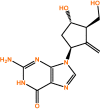Entecavir: A Review and Considerations for Its Application in Oncology
- PMID: 38004468
- PMCID: PMC10675314
- DOI: 10.3390/ph16111603
Entecavir: A Review and Considerations for Its Application in Oncology
Abstract
Entecavir (ETV) is a drug used as a first-line treatment for chronic hepatitis B (CHB) virus infection because it is a guanosine nucleoside analogue with activity against the hepatitis B virus polymerase. The ETV dosage can range from 0.5 mg to 1 mg once a day and the most common side effects include headache, insomnia, fatigue, dizziness, somnolence, vomiting, diarrhea, nausea, dyspepsia, and increased liver enzyme levels. In addition to its conventional use, ETV acts as an inhibitor of lysine-specific demethylase 5B (KDM5B), an enzyme that is overexpressed in breast, lung, skin, liver, and prostate tumors and is involved in the hormonal response, stem cell regeneration, genomic stability, cell proliferation, and differentiation. The KDM5B enzyme acts as a transcriptional repressor in tumor suppressor genes, silencing them, and its overexpression leads to drug resistance in certain tumor types. Furthermore, the literature suggests that KDM5B activates the PI3K/AKT signaling pathway, while reducing KDM5B expression decreases AKT signaling, resulting in decreased tumor cell proliferation. In silico studies have demonstrated that ETV can inhibit tumor cell proliferation and induce apoptosis by reducing KDM5B expression. ETV also appears to inhibit PARP-1, has a high genetic barrier, reducing the chance of resistance development, and can also prevent the reactivation of the hepatitis B virus in cancer patients, which have proven to be significant advantages regarding its use as a repurposed drug in oncology. Therefore, ETV holds promise beyond its original therapeutic indication.
Keywords: KDM5B inhibitor; antiviral drug; drug repurposing; entecavir; hepatitis B.
Conflict of interest statement
The authors declare no conflict of interest.
Figures
References
-
- Hepatitis B. [(accessed on 7 August 2023)]. Available online: https://www.who.int/news-room/fact-sheets/detail/hepatitis-b.
-
- Lee K.S., Kweon Y.O., Um S.H., Kim B.H., Lim Y.S., Paik S.W., Heo J., Lee H.J., Kim D.J., Kim T.H., et al. Efficacy and Safety of Entecavir versus Lamivudine over 5 Years of Treatment: A Randomized Controlled Trial in Korean Patients with Hepatitis B e Antigen-Negative Chronic Hepatitis B. Clin. Mol. Hepatol. 2017;23:331–339. doi: 10.3350/cmh.2016.0040. - DOI - PMC - PubMed
Publication types
LinkOut - more resources
Full Text Sources
Miscellaneous



